(click on photos to enlarge images)
HISTORY AND MARKS OF HAMILTON & CO. CALCUTTA
(WITH THE KIND CO-OPERATION AND SUPERVISION OF MR. WYNYARD
WILKINSON)
Robert Hamilton (1772-1848) arrived in India and started work in
Calcutta in 1808. He opened his Jewellery and Silversmithing
shop at 5 Tank Square in 1808 under licence from the East Indian
Company (1).
In 1811 the business moved to 7 Court House Street, where it
remained until 1973 when it finally closed. Needing capital to
expand the business Robert Hamilton took two partners, Henry and
James Glazbrook in 1811. Robert Hamilton’s interest ceased in
1817, and he dedicated the latter part of his life to collecting
paintings, including works by Rubens, Velazquez and Holbein.
During the subsequent years the business had many partners
including: Henry and James Glazbrook, James Middleton, George
Thoerpe, Charles Galliards, Alexander Rogers II, Henry Augustus
Woolaston, William , Joseph, John and George Farrell Remfry,
Robert John Dring and Thomas William Brookes.
H&Co opened branches in other parts of India: Bombay (1833-36
and from 1868); Delhi and Simla (1865 onwards).
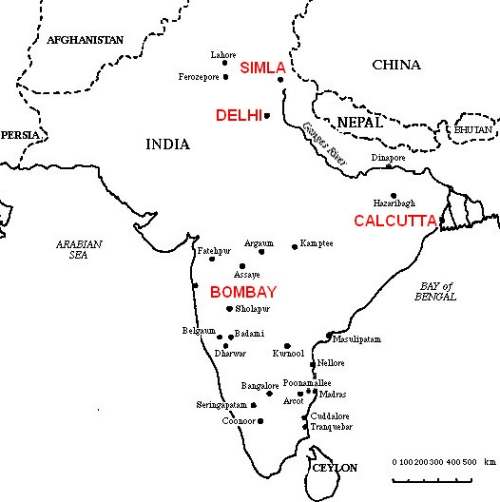 |
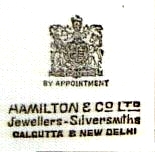 |
|
Historical map of India
|
Trade mark struck on an art deco style brushes
set
circa 1930/1940.
|
A
few bibliographic sources are available to reconstruct
the silver marks used at different times by Hamilton &
Co. Jackson: (reference 1), in his famous book on
British hallmarks of the beginning of 20th century gives
only a small amount of information about Hamilton & Co.. Furthermore
citations are reported as personal communication rather
than written documents.
The more exhaustive description (at least covering the
first half of XIX century) is given by Wynyard Wilkinson
(reference 2), in his famous and very rare book
(only 1,000 copies produced) devoted to British
silversmiths operating in India.
Hamilton & Co. is probably the best known and celebrated
British silversmith operating in India (he is known as
the Garrard of India). Among the main commissions
received there is a vase for Rundell Bridge and Rundell in
1825. In 1844 Hamilton & Co. invents the Toffee pot, a
coffee pot that can be also used as a teapot. His silver
works are always elegant with minimal decoration (mainly
plain design) and of great consistency as I have realized
from the five items belonging to my collections
(crafted between 1812 and 1970) and other items found on
line.
The following table reports examples of marks both as
reported by Wynyard Wilkinson, and derived from a deep
(although not exhaustive) research on the internet and in other
bibliographic sources. The reported marks include those
found on the items belonging to my personal collection
(link for description are reported in the last column). |
MARK
|
DATE LETTER
|
PERIOD
|
SOURCE
|
REMARKS
|
 |
-
|
1808 1817
|
a
|
Before Hamilton & Co. foundation the marks were
an elephant, a capital letter A and the Robert
Hamilton initials (R H)
|
 |
-
|
1812
|
d
|
Now the maker's marks is H & Co. This mark is
the only one reported by Jackson (1) for Hamilton &
Co., stating that it was used since 1810. The real
date of the mark cannot be before 1812 (date of
foundation of Hamilton & Co.)
|
 |
-
|
1812 1820
|
a
|
At this date the previous marks are accompanied
by an urn and a symbol similar to a tailed sphere
with some smaller spheres around
|
 |
-
|
1812 1820
|
b
|
A variant of the above marks. The sequence of
single marks (impressed one by one) seems to be
casual
see the item description
|
 |
-
|
1821 1845
|
a
|
The elephant and the urn are struck in punches
which follow the borders of the symbols and the
letter 'A'. A new symbol (a thistle ?) is now struck
instead of the tailed sphere
|
 |
-
|
1850 1860
|
a
|
The urn is no longer struck in the sequence of
marks, but the thistle still continues to be used
|
| |
-
|
1868
|
a
|
Since this date, on marks struck on items
crafted at the Bombay branch, the A is missing. It
is not clear how long this kind of mark was in use
|
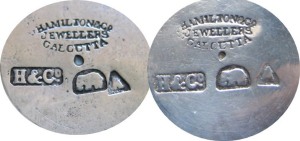

 |
-
|
1860 1914
?
|
c
|
|
| |
-
|
1912
|
e
|
The maker's marks is still H & Co
|
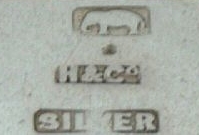
 |
-
|
1914
|
c
|
Mark found on a little item engraved with a
presentation including the date of 1914. Of course
the item could be marked before this date. The mark
is without the capital A and bears the word 'silver'
which was then struck at least from this date on
Mark found on a couple of brushes contained in a case bearing the trade mark you can see by
clicking on this
link. The inscription refers to a king, so the date of the mark
should be between 1901 and 1926 (see below). But, as the letter 'A' is missing, we can
date this item between 1914 and 1926.
|
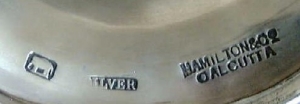 |
-
|
1926
|
c
|
Mark found on a trophy cup with an inscription including the date of 1926. There
is not the traditional trade mark, but the impression 'Hamilton & Co. Calcutta' .
Of course this item could have been marked before this date, but it is likely that the
inscription is contemporary to the mark
|
 |
-
|
1932 1937
|
b, c
|
The maker's mark is now H & Co Ltd. It is not clear when Hamilton & Co.
changed its status in Limited, but, according to the mark above, this should be after
1926
see the item description
This could be the 1937 mark (in this year a date
letter was introduced, see below) On an item
with an engraved presentation citing the date 1932,
the marks are similar but the capital letter A is
missing. It may be that after the introduction of the
world 'silver' the capital A was omitted until
1937.
|
| |
A
|
1937
or
1962
|
a
|
From 1937 a date letter was introduced in place
of the traditional Roman 'A'. The series ran until H &
Co Ltd. closed in 1973, with 25 letters of the Roman
Alphabet (leaving out the 'J'), recommencing with a
new Roman 'A' in 1962
|
| |
B
|
1938
or
1963
|
a
|
|
| |
C
|
1939
or
1964
|
a
|
|
| |
D
|
1940
or
1965
|
a
|
|
| |
E
|
1941
or
1966
|
a
|
|
 |
F
|
1942
or
1967
|
a
|
|
| |
G
|
1943
or
1968
|
a
|
|
| |
H
|
1944
or
1969
|
a
|
|
 |
I
|
1945
or
1970
|
a, b
|
|
 |
K
|
1946
or
1971
|
a, c
|
|
| |
L
|
1947
or
1972
|
a
|
|
| |
M
|
1948
or
1973
|
a
|
|
| |
N
|
1949
|
a
|
|
| |
O
|
1950
|
a
|
|
| |
P
|
1951
|
a
|
|
| |
Q
|
1952
|
a
|
|
| |
R
|
1953
|
a
|
|
 |
S
|
1954
|
a
|
At least from this date on, but probably earlier, the maker's mark of Hamilton
& Co Ltd assumed the characteristic tri-lobed shape
|
| |
T
|
1955
|
a
|
|
| |
U
|
1956
|
a
|
|
| |
V
|
1957
|
a
|
|
| |
W
|
1958
|
a
|
|
| |
X
|
1959
|
a
|
|
| |
Y
|
1960
|
a
|
|
 |
Z
|
1961
|
a, c
|
|
MARK
|
DATE LETTER
|
PERIOD
|
SOURCE
|
REMARKS
|
a (reference 2)
b Private Collection
c Information found on line
d (reference 1)
e John Culme 'The Directory of Gold & Silversmiths' (1987). Oral
communication.
REFERENCES
(1) Charles J. Jackson, 1964: ENGLISH GOLDSMITHS AND THEIR MARKS
- A History of the Goldsmiths and Plate Workers of England,
Scotland and Ireland. Second Edition, Dover Publications Inc.,
New York.
(2) Wynyard R.T. Wilkinson, 1987: INDIAN COLONIAL SILVER– EUROPEAN SILVERSMITHS IN INDIA
(1790 - 1860) AND THEIR MARKS. - R.T.W. Wilkinson ed., London.
|
 ASSOCIATION OF SMALL COLLECTORS OF ANTIQUE SILVER
ASSOCIATION OF SMALL COLLECTORS OF ANTIQUE SILVER

















